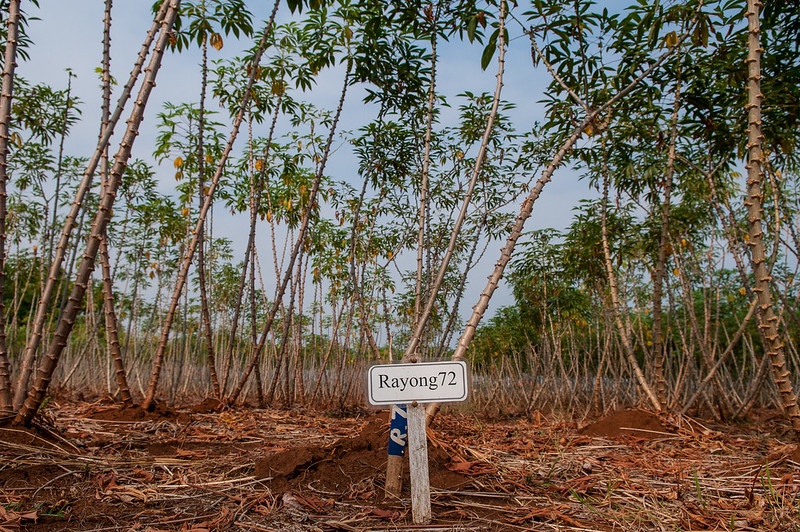ដំឡូងមី គឺជាដំណាំមួយដ៏សំខាន់ក្នុងវិស័យកសិកម្មនៅព្រះរាជាណាចក្រកម្ពុជា។ ការដាំដុះ ការប្រមូលផល ការកែច្នៃ និងការនាំចេញដំឡូងមីបានផ្តល់ការងារ និងគាំទ្រដល់ការរស់នៅរបស់ប្រជាជនកម្ពុជាជាច្រើនពាន់នាក់។ ដំឡូងមីជាដំណាំដែលអាចឱ្យប្រជាកសិករខ្មែររកចំណូលបានពីការដាំដុះមួយផ្នែកផងដែរ។1 ផលិតកម្មដំឡូងមីនៅក្នុងប្រទេសកម្ពុជាមានការកើនឡើងគួរឱ្យកត់សម្គាល់ចាប់តាំងពីឆ្នាំ ២០០៦។ ទោះបីជាមានការភ្ញាក់ផ្អើលដល់ទីផ្សារនាពេលថ្មីៗនេះក៏ដោយ ក៏ដំឡូងមីបានកើនឡើងយ៉ាងឆាប់រហ័សពីដំណាំសាមញ្ញ ទៅជាដំណាំដែលត្រូវបានគេរាយការណ៍ច្រើនបំផុតទី២ នៅក្នុងវិស័យកសិកម្ម។2
ដំឡូងមី គឺជារុក្ខជាតិដែលផ្ទុកកាបូអ៊ីដ្រាតខ្ពស់ និងអាចរស់រានបាននៅពេលមានគ្រោះរាំងស្ងួត និងដីគ្មានជីជាតិ ក្នុងចំណោមដំណាំស្បៀងរបស់ប្រជាជនក្រីក្រក្នុងតំបន់ត្រូពិច និងអនុតំបន់ត្រូពិច។ រុក្ខជាតិប្រភេទនេះក៏មានបញ្ហាជាមួយនឹងពពួកសត្វល្អិត និងជំងឺនៅពេលដាំដុះនៅអាស៊ីអាគ្នេយ៍ផងដែរ។3 ជាប្រពៃណីនៃការដាំដុះនៅក្នុងគ្រួសារដែលមានជីវភាពក្រីក្រ ដំឡូងមីមានការលំបាកក្នុងការដាំដុះក្នុងលក្ខណៈទ្រង់ទ្រាយធំ ព្រោះវាត្រូវបានដាំពីការកាត់ដើម ដែលពិបាកក្នុងការថែទាំ និងរក្សាទុក។ ការដាំដុះដំឡូងមីពឹងផ្អែកលើកម្លាំងពលកម្មច្រើនផងដែរ។ តម្រូវការកើនឡើងនៃដំឡូងមីនៅទូទាំងពិភពលោក ត្រូវបានគេរំពឹងថានឹងនាំទៅរកការផ្លាស់ប្តូរបច្ចេកវិទ្យាក្នុងការដាំដុះឬស។4 សព្វថ្ងៃនេះ ដំឡូងមីត្រូវបានដាំដុះនៅខេត្តបាត់ដំបង ប៉ៃលិន បន្ទាយមានជ័យ ក្រចេះ និងកំពង់ធំ។ វាត្រូវបានដាំនៅខែឧសភា និងប្រមូលផលនៅចន្លោះខែវិច្ឆិកា និងចុងខែកុម្ភៈ ជារៀងរាល់ឆ្នាំ។5

ដំឡូងមីដែលមានសុខភាពល្អនៅដីឡូតិ៍CIATក្នុងប្រទេសកម្ពុជា។ រូបភាពដោយ CIAT ថតនៅថ្ងៃទី២៥ ខែមីនា ឆ្នាំ២០១៤។ អាជ្ញាប័ណ្ណ CC BY-NC-SA 2.0។
ឧស្សាហកម្មដំឡូងមី
នៅខែធ្នូ ឆ្នាំ ២០១១ ប្រទេសកម្ពុជាបានចូលរួមក្នុងគម្រោងត្រីភាគីជាមួយ យូអិនឌីភី និងប្រទេសចិន ដែលបានបញ្ចប់នៅខែមីនា ឆ្នាំ ២០១៥។ គម្រោងនេះមានសកម្មភាពជាច្រើនដូចជា៖ ការបណ្តុះបណ្តាលកសិករដាំដំឡូងមីនៅកម្ពុជា និងការផ្គូរផ្គងអាជីវកម្ម ដើម្បីបង្កើតការតភ្ជាប់នៅក្នុងទីផ្សារពាណិជ្ជកម្មដំឡូងមី។6 ផ្ទៃដីដាំដុះដំឡូងមីនៅកម្ពុជាបានពង្រីកពីតិចជាង ២៦.០០០ហិកតា ក្នុងឆ្នាំ ២០០៣ ទៅ ៤០០.០០០ហិកតា ក្នុងឆ្នាំ ២០១១7 និងដល់ ៦៥៦.៨៦៨ហិកតា នៅឆ្នាំ ២០២១។ ទិន្នផលរបស់វាគឺច្រើនជាង ១២លានតោនក្នុងមួយឆ្នាំ ឬជាង ១៨ តោនក្នុងមួយហិកតា។8 ដំឡូងមីត្រូវបាននាំចេញទៅក្នុងទីផ្សារប្រមាណ ៣,២៩លានតោនក្នុងឆ្នាំ ២០១៩។9 ដំឡូងមីស្រស់ជាង ១២ លានតោនត្រូវបានប្រមូលនៅឆ្នាំ ២០២០។10 នៅក្នុងរយៈពេលបួនខែដំបូងនៃឆ្នាំ ២០២១ ដំឡូងមីកើនឡើងពី ១,៣ លានតោន ក្នុងរយៈពេលដូចគ្នាក្នុងឆ្នាំ ២០២០។11 កម្ពុជាបាននាំចេញដំឡូងមីជាង ១,៥ លានតោន ទៅកាន់ទីផ្សារអន្តរជាតិដូចជា ថៃ វៀតណាម ចិន អ៊ីតាលី និងហូឡង់។12
ឧស្សាហកម្មដំឡូងមីកម្ពុជាពឹងផ្អែកទាំងស្រុង លើទីផ្សារព្រំដែនថៃ និងវៀតណាម ដែលជាឈ្មួញកណ្តាលពាណិជ្ជកម្មដំឡូងមី រវាងទីផ្សារកម្ពុជា និងអន្តរជាតិ និងចិន។ ដូច្នេះទីផ្សារអន្តរជាតិមានឥទ្ធិពលលើតម្រូវការដំឡូងមីក្នុងប្រទេសកម្ពុជា។ ការកែច្នៃដំឡូងមីនៅកម្ពុជាមានបីប្រភេទរួមមាន៖ បន្ទះដំឡូងមីស្ងួត ម្សៅស្ងួត និងម្សៅសើម។13
តម្លៃលើទីផ្សារ
ផលិតកម្មដំឡូងមីនៅប្រទេសកម្ពុជា បានចាប់ផ្តើមក្នុងឆ្នាំ ២០០១ ហើយបានកើនឡើងយឺតៗ រហូតដល់ឆ្នាំ ២០០៦ នៅពេលមានតម្រូវការ និងតម្លៃកើនឡើង។14 បន្ទាប់មកនៅឆ្នាំ ២០០៨ តម្លៃដំឡូងមីនៅទូទាំងពិភពលោកបានធ្លាក់ចុះ15 ហើយព្រំដែនថៃ-កម្ពុជាត្រូវបានបិទ ដែលធ្វើឱ្យបាត់ទីផ្សារពាណិជ្ជកម្មដំឡូងមី។16 បន្ទាប់មក ប្រទេសថៃបានលុបចោលការរឹតត្បិតលើការនាំចូលដំឡូងមីក្នុងឆ្នាំ ២០១៣។17 ជាមួយនឹងការពន្យាពេលនៃការប្រមូលផលដំឡូងមី ដោយសារទឹកជំនន់ក្នុងឆ្នាំ ២០២០ តម្លៃដំឡូងមីស្រស់បានកើនឡើងដល់ ៣៥០ រៀល (០.០៨៦ ដុល្លារ) ក្នុងមួយគីឡូក្រាម និង ៨៦០-៩១៥រៀល (០,២១-០,២២ ដុល្លារ) សម្រាប់ដំឡូងមីស្ងួត ខណៈពេលដែលឈ្មួញចំណាយត្រឹមតែ ២០០រៀល (០.០៤៩ ដុល្លារ) សម្រាប់ដំឡូងមីស្រស់ និង ៦៥០-៦៧០រៀល (០,១៦ ដុល្លារ) សម្រាប់ដំឡូងស្ងួតនៅពេលមុនៗ។18 តម្លៃដំឡូងមីគឺ ៣៣០-៣៧០រៀល (០,០៨-០,០៩ ដុល្លារ) ក្នុងមួយគីឡូក្រាមនៅឆ្នាំ ២០២១ គឺឡើងថ្លៃពី ២២០-២៦០រៀល ក្នុងឆ្នាំ ២០២០ ហើយបន្ទះដំឡូងមីមានតម្លៃរហូតដល់ ៧១៥-៨០០រៀល ពោលគឺកើនឡើងពី ៥២០-៦៥០រៀល។19
ផលិតកម្មជីវឥន្ធនៈ
ដោយសារតែសំបូរសារធាតុកាបូអ៊ីដ្រាត ដំឡូងមីគឺជាដំណាំដ៏មានសក្តានុពលក្នុងការផលិតអេតាណុល។20 ក្រុមហ៊ុន អឹម អេស គ្រុប នៃប្រទេសកូរ៉េខាងត្បូងបានវិនិយោគលើរោងចក្រផលិតជីវៈអេតាណុលដំបូងគេបង្អស់នៅកម្ពុជា ដែលចំណាយទុនប្រមាណ ៤០លានដុល្លារ។ រោងចក្រនេះប្រើប្រាស់ម្សៅដំឡូងមីជាវត្ថុធាតុដើមក្នុងដំណើរការផលិតកម្ម។21 ក្រុមហ៊ុនធ្លាប់បានផ្អាកផលិតកម្ម ដោយសារតែតម្លៃដំឡូងមីស្ងួតឡើងថ្លៃនៅក្នុងខែមេសា ឆ្នាំ ២០១០ ប៉ុន្តែរោងចក្របានបើកដំណើរការឡើងវិញនៅខែកក្កដា ឆ្នាំ២០១០ នៅរដូវប្រមូលផលដំឡូងមី។ នៅក្រោមការបណ្តាក់ទុនរួមគ្នាជាមួយក្រុមហ៊ុន អឹម អេស ជីវថាមពល គ្រុប ជីវៈអេតាណុលចំនួន ៣៦លានលីត្រ ត្រូវបានផលិតជារៀងរាល់ឆ្នាំពីដំឡូងមី។22
ក្រុមហ៊ុនជីវឥន្ធនៈចិន Henan Tianguan Group និង Cambodian Advanced Glory Logistics រួមគ្នាបង្កើតបន្ទះដំឡូងមី ដែលនាំទៅកាន់ប្រទេសចិនសម្រាប់ផលិតជីវឥន្ធនៈនៅឆ្នាំ ២០១៥។23 ប្រទេសកម្ពុជាក៏កំពុងទាក់ទាញការវិនិយោគលើផលិតកម្មជីវឥន្ធនៈក្នុងស្រុកផងដែរ។ ក្រុមហ៊ុនជប៉ុន Idemitsu កំពុងធ្វើការសិក្សារយៈពេល ៣ឆ្នាំ ដើម្បីសាងសង់រោងចក្រផលិតជីវៈអេតាណុល។24
គោលនយោបាយជាតិថ្មី
នៅថ្ងៃទី ១៤ ខែមករា ឆ្នាំ ២០២១ ក្រសួងកសិកម្ម រុក្ខាប្រមាញ់ និងនេសាទ និងយូអិនឌីភី បានដាក់ចេញនូវគោលនយោបាយដំឡូងមីជាតិថ្មីមួយ ដើម្បីជម្រុញការផលិត និងនាំចេញដំឡូងមីរបស់កម្ពុជា។ គោលការណ៍នេះត្រូវបានដំណើរការរហូតដល់ឆ្នាំ ២០២៥។ គោលនយោបាយនេះត្រូវបានបង្កើតឡើងដោយក្រុមការងារលើវិស័យដំឡូងមីរបស់រដ្ឋាភិបាល និងត្រូវបានអនុម័តដោយរាជរដ្ឋាភិបាលកម្ពុជា នៅថ្ងៃទី ១៤ ខែសីហា ឆ្នាំ ២០២០។25
ទាក់ទងនឹងដំឡូងមី
- កសិកម្ម និង ការនេសាទ
- ផលិតកម្មផ្នែកកសិកម្ម
- គោលនយោបាយ និងការគ្រប់គ្រងវិស័យកសិកម្ម
- ផលិតកម្មថាមពលកើតឡើងវិញ
ឯកសារយោង
- 1. យូអិនឌីភី, “គោលនយោបាយដំឡូងមីថ្មីដើម្បីផ្លាស់ប្តូរផលិតកម្មដំណាំសំខាន់,” ថ្ងៃទី១៤ ខែមករា ឆ្នាំ២០២១, បានចូលអាននៅថ្ងៃទី២១ ខែកក្កដា ឆ្នាំ២០២១។
- 2. វិទ្យាស្ថានជាតិស្ថិតិនៃក្រសួងផែនការ, “ជំរឿនកសិកម្មកម្ពុជាឆ្នាំ២០១៣៖ របាយការណ៍បឋម,” ឆ្នាំ២០១៣, បានចូលអាននៅថ្ងៃទី២១ ខែកក្កដា ឆ្នាំ២០២១។
- 3. Hought, Joy et al., “ជីវឥន្ធនៈ ការផ្លាស់ប្តូរការប្រើប្រាស់ដី និងការប្រកបរបរចិញ្ចឹមជីវិតរបស់កសិករខ្នាតតូច៖ ករណីសិក្សាក្នុងស្រុកបន្ទាយឆ្មារ ប្រទេសកម្ពុជា,” ភូមិសាស្ត្រអនុវត្ត ៣២, លេខ ២ (២០១២): ៥២៥-៥៣២, បានចូលអាននៅថ្ងៃទី២១ ខែកក្កដា ឆ្នាំ២០២១។
- 4. Howeler, Reinhardt, NeBambi Lutaladio និង Graeme Thomas, “សង្គ្រោះ និងដាំដុះ៖ ដំឡូងមី,” អង្គការស្បៀងអាហារ និងកសិកម្ម, ឆ្នាំ២០១៣, បានចូលអាននៅថ្ងៃទី២១ ខែកក្កដា ឆ្នាំ២០២១។
- 5. ហ៊ឹន ពិសី, “តម្លៃដំឡូងមីនៅតែថេរដដែល,” ភ្នំពេញប៉ុស្តិ៍, ថ្ងៃទី០៣ ខែកុម្ភៈ ឆ្នាំ២០២០, បានចូលអាននៅថ្ងៃទី២១ ខែកក្កដា ឆ្នាំ២០២១។
- 6. យូអិនឌីភី, “ជោគជ័យនៃកិច្ចសហប្រតិបត្តិការត្រីភាគីសម្រាប់គម្រោងដំឡូងមីចិន-កម្ពុជា-យូអិនឌីភី,” ឆ្នាំ២០១៤, បានចូលអាននៅថ្ងៃទី២១ ខែកក្កដា ឆ្នាំ២០២១។
- 7. ក្រសួងកសិកម្ម រុក្ខាប្រមាញ់ និងនេសាទ, “សៀវភៅដំឡូងមី,” គម្រោងដំឡូងមីសហប្រតិបត្តិការត្រីភាគីចិន-កម្ពុជា-យូអិនឌីភីដំណាក់កាលទី២, ខែមីនា ឆ្នាំ២០១៥, បានចូលអាននៅថ្ងៃទី២១ ខែកក្កដា ឆ្នាំ២០២១។
- 8. ហ៊ីន ពិសី, “ការនាំចេញដំឡូងមីមានល្បឿនលឿនជាងឆ្នាំ២០២០ ក្នុងខែមករា-មេសា,” ភ្នំពេញប៉ុស្តិ៍, ថ្ងៃទី០៦ ខែឧសភា ឆ្នាំ២០២១, បានចូលអាននៅថ្ងៃទី២១ ខែកក្កដា ឆ្នាំ២០២១។
- 9. ធូ វិរៈ, “ការនាំចេញផលិតផលដំឡូងមីកើនឡើង ៤៩ ភាគរយ,” ភ្នំពេញប៉ុស្តិ៍, ថ្ងៃទី១៣ ខែតុលា ឆ្នាំ២០១៩, បានចូលអាននៅថ្ងៃទី២១ ខែកក្កដា ឆ្នាំ២០២១។
- 10. យូអិនឌីភី,”គោលនយោបាយដំឡូងមីថ្មីដើម្បីផ្លាស់ប្តូរផលិតកម្មដំណាំសំខាន់,” ថ្ងៃទី១៤ ខែមករា ឆ្នាំ២០២១, បានចូលអាននៅថ្ងៃទី២១ ខែកក្កដា ឆ្នាំ២០២១។
- 11. ហ៊ឹន ពិសី, “តម្លៃដំឡូងមីកើនឡើងដោយសារការប្រមូលផលយឺត,” ភ្នំពេញប៉ុស្តិ៍, ថ្ងៃទី១៣ ខែធ្នូ ឆ្នាំ២០២០, បានចូលអាននៅថ្ងៃទី២១ ខែកក្កដា ឆ្នាំ២០២១។
- 12. ហ៊ឹន ពិសី, “ការនាំចេញដំឡូងមីមានល្បឿនលឿនជាងឆ្នាំ២០២០ ក្នុងខែមករា-មេសា,” ភ្នំពេញប៉ុស្តិ៍, ថ្ងៃទី០៦ ខែឧសភា ឆ្នាំ២០២១, បានចូលអាននៅថ្ងៃទី២១ ខែកក្កដា ឆ្នាំ២០២១។
- 13. ក្រសួងកសិកម្ម រុក្ខាប្រមាញ់ និងនេសាទ, "សៀវភៅដំឡូងមី," គម្រោងដំឡូងមីសហប្រតិបត្តិការត្រីភាគីចិន-កម្ពុជា-យូអិនឌីភីដំណាក់កាលទី២, ខែមីនា ឆ្នាំ២០១៥, បានចូលអាននៅថ្ងៃទី២១ ខែកក្កដា ឆ្នាំ២០២១។
- 14. Hought, Joy et al., “ជីវឥន្ធនៈ ការផ្លាស់ប្តូរការប្រើប្រាស់ដី និងការប្រកបរបរចិញ្ចឹមជីវិតរបស់កសិករខ្នាតតូច៖ ករណីសិក្សាពីបន្ទាយឆ្មារ ប្រទេសកម្ពុជា," ភូមិសាស្ត្រអនុវត្ត ៣២, លេខ ២ (២០១២): ៥២៥-៥៣២, បានចូលអាននៅថ្ងៃទី២១ ខែកក្កដា ឆ្នាំ២០២១។
- 15. អង្គការស្បៀងអាហារ និងកសិកម្ម, "ដំឡូងមី៖ ការដកស្រង់អន្តរជាតិចេញពីកំណត់ត្រាខ្ពស់," ទស្សនៈវិស័យម្ហូបអាហារ, ខែវិច្ឆិកា ឆ្នាំ២០០៨, បានចូលអាននៅថ្ងៃទី២១ ខែកក្កដា ឆ្នាំ២០២១។
- 16. សម រង្សី, "ការពារកសិករ," ភ្នំពេញប៉ុស្តិ៍, ថ្ងៃទី១០ ខែមីនា ឆ្នាំ២០០៩, បានចូលអាននៅថ្ងៃទី២១ ខែកក្កដា ឆ្នាំ២០២១។
- 17. បុគ្គលិកភ្នំពេញប៉ុស្តិ៍, "ថៃដកចេញច្បាប់នាំចូលដំឡូងមី និងពោត," ភ្នំពេញប៉ុស្តិ៍, ថ្ងៃទី០៦ ខែសីហា ឆ្នាំ២០១៣, បានចូលអាននៅថ្ងៃទី២១ ខែកក្កដា ឆ្នាំ២០២១។
- 18. ហ៊ឹន ពិសី, "តម្លៃដំឡូងមីកើនឡើងដោយសារការប្រមូលផលយឺត," ភ្នំពេញប៉ុស្តិ៍, ថ្ងៃទី១៣ ខែធ្នូ ឆ្នាំ២០២០, បានចូលអាននៅថ្ងៃទី២១ ខែកក្កដា ឆ្នាំ២០២១។
- 19. ហ៊ឹន ពិសី, "ការនាំចេញដំឡូងមីមានល្បឿនលឿនជាងឆ្នាំ២០២០ ក្នុងខែមករា-មេសា," ភ្នំពេញប៉ុស្តិ៍, ថ្ងៃទី០៦ ខែឧសភា ឆ្នាំ២០២១, បានចូលអាននៅថ្ងៃទី២១ ខែកក្កដា ឆ្នាំ២០២១។
- 20. Hought, Joy et al., “ជីវឥន្ធនៈ ការផ្លាស់ប្តូរការប្រើប្រាស់ដី និងការប្រកបរបរចិញ្ចឹមជីវិតរបស់កសិករខ្នាតតូច៖ ករណីសិក្សាក្នុងស្រុកបន្ទាយឆ្មារ ប្រទេសកម្ពុជា," ភូមិសាស្ត្រអនុវត្ត ៣២, លេខ ២ (២០១២): ៥២៥-៥៣២, បានចូលអាននៅថ្ងៃទី២១ ខែកក្កដា ឆ្នាំ២០២១។
- 21. សេវាកម្មអន្ដរជាតិសម្រាប់ការទទួលពាក្យសុំជីវបច្ចេកវិទ្យា, "ប្រទេសកម្ពុជាបើកដំណើរការរោងចក្រផលិតអេតាណុលដំឡូងមីដំបូងរបស់ខ្លួន," ឆ្នាំ២០០៨, បានចូលអាននៅថ្ងៃទី២១ ខែកក្កដា ឆ្នាំ២០២១។
- 22. ធនាគារអភិវឌ្ឍន៍អាស៊ី,"កម្ពុជា៖ ការវាយតម្លៃវិស័យថាមពល យុទ្ធសាស្ត្រ និងផែនទីបង្ហាញផ្លូវ," ខែធ្នូ ឆ្នាំ២០១៨, បានចូលអាននៅថ្ងៃទី២១ ខែកក្កដា ឆ្នាំ២០២១។
- 23. Styllis, George និង Ouch Sony, “ការដឹកជញ្ជូនដំឡូងមីដំបូងគេនៃកំពង់ផែធំៗ," ខេមបូឌាដេលី, ថ្ងៃទី០៥ ខែមករា ឆ្នាំ២០១៥, បានចូលអាននៅថ្ងៃទី២១ ខែកក្កដា ឆ្នាំ២០២១។
- 24. បុគ្គលិកសារព័ត៌មានខេមបូឌាដេលី, "ពាណិជ្ជករអ៊ីស្រាអែលចាប់អារម្មណ៍ក្នុងការវិនិយោគដំឡូងមីនៅកម្ពុជា," អង្គការទិន្នន័យអំពីការអភិវឌ្ឍ, ឆ្នាំ២០១៤, បានចូលអាននៅថ្ងៃទី២១ ខែកក្កដា ឆ្នាំ២០២១។
- 25. យូអិនឌីភី, "គោលនយោបាយដំឡូងមីថ្មីដើម្បីផ្លាស់ប្តូរផលិតកម្មដំណាំសំខាន់," ថ្ងៃទី១៤ ខែមករា ឆ្នាំ២០២១, បានចូលអាននៅថ្ងៃទី២១ ខែកក្កដា ឆ្នាំ២០២១។

